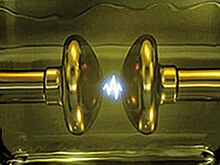Spark gap
A spark gap is the discharge space between two conductors ( electrodes ) in which there is a gas (e.g. air). If the voltage between the two electrodes rises to the flashover voltage , the resulting electrical field leads to ionization of the gas in the discharge space, this becomes conductive and the path is (short) closed by a spark within fractions of a microsecond due to impact ionization .
General
Spark gaps can be triggered by ionizing radiation ( ultraviolet radiation , X-rays , gamma radiation , charged particles). The flashover voltage of a spark gap drops due to ionizing radiation and moisture. A pointed shape of the electrodes also lowers the flashover voltage, resulting in locally increased field strength and pre-discharges .
Example: In dry air under standard conditions (atmospheric pressure), depending on the prevailing gas, around 1 kV are required per millimeter between the conductors until a spark occurs. This value can fluctuate and deviate considerably due to the type of gas or gas mixture and depending on the air humidity and air pressure (see Paschen's law ).
One form of the spark gap is the quenching spark gap or deion chamber . In this case, metallic subdivisions ensure that the switching arc splits up into partial arcs and, if the voltage falls below the individual burning voltages, it fades (extinguishes) with reduced contact erosion. With the historical design of the extinguishing spark transmitter , this effect was used in combination with an oscillating circuit to generate damped vibrations.
Unintentional flashovers can occur on open designs of spark gaps in the open air if these insects have accumulated. This can be avoided by using compressed air that is blown through the spark gap.
Applications

1 - main electrode
2 - auxiliary electrode
3 - insulator
H - auxiliary pulse source
The pop-spark transmitter developed by the Marconi Company around 1901 is based on experiments by Heinrich Hertz and used a spark gap to generate radio waves . The spark created in this arrangement gave the wireless radio transmission its name. Around 1905 Max Wien developed the extinguishing spark transmitter , which allowed higher repetition frequencies of the sparks. A switching spark gap also works in the primary circuit of the Tesla transformer .
Nitrogen lasers and other devices also use switching spark gaps to generate high-energy, very short current and voltage pulses. With the spark plug in the gasoline engine , a spark is used to ignite the fuel-air mixture. The Jakobsleiter represents a special geometric shape of a spark gap . Marx generators require spark gaps and possibly also a trigger or switching spark gap, Trigatron , to function . Spark chambers register the passage of elementary particles (e.g. muons ) - sparks are generated along the flight path of the particles. In spark erosion material processing , metal is removed with high accuracy using a very short spark gap in a liquid.
Spark gaps used to be used as simple and very coarse surge arresters in the area of the insulators of overhead lines . These spark gaps are in the form of horns at the ends of the insulator and should not be confused with the similar-looking corona rings . The horns are used to keep the very hot arc away from the insulator in the event of a flashover and thus to prevent damage to the insulator.
However, since the open arc between the horns leads to an uncontrollable ionization of the air in the environment, which is transported by wind and thermal air currents, and due to the high instantaneous power that occurs in electrical energy networks, these powerful discharges can lead to additional flashovers on neighboring parts of the overhead line with consequential failures to lead. To protect against overvoltage in overhead lines, encapsulated surge arresters, consisting of varistors or gas arresters , with better defined ignition behavior and discharge capacity are therefore increasingly being used instead of open horns .
Spark gaps are also used as surge protection on insulators in self-radiating transmitter masts . This overvoltage occurs in particular as a result of atmospheric charges - such as approaching thunderstorms. However, the arc power that occurs is low, so that the arc does not cause any significant damage to the spark gaps.
See also
Web links
- Video of a rollover on a high-voltage isolator chain simulated in the laboratory.
Individual evidence
- ↑ Axel Rossmann: Structure formation and simulation of technical systems Volume 1: The static basics of simulation . Springer-Verlag, 2016, ISBN 978-3-662-46766-4 ( limited preview in Google Book Search [accessed December 1, 2016]).
- ↑ Joachim Heintze: Textbook on Experimental Physics Volume 3: Electricity and Magnetism . Springer-Verlag, 2016, ISBN 978-3-662-48451-7 ( limited preview in Google Book Search [accessed December 1, 2016]).
- ↑ waniewski.de: Wavre MW Diplexer 2DE


